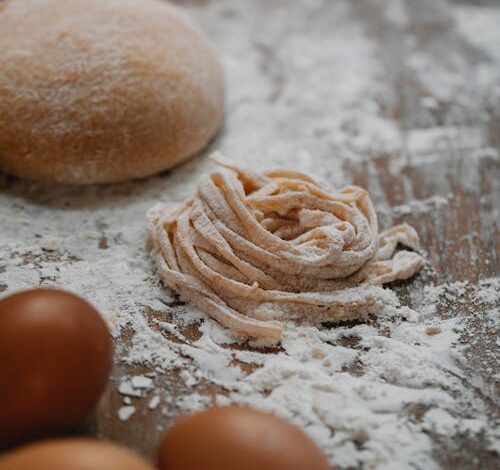
What is Protein Pasta? Pasta that has been enhanced with extra protein, such as quinoa, lentils, or chickpeas, is known as protein pasta. Because it is strong in protein, low in carbohydrates, and high in fiber, it is a fantastic substitute for traditional pasta. For vegans looking to spice up their meals, protein spaghetti is a great choice.
In addition, protein pasta is a wholesome choice for those who wish to enjoy a healthier substitute for regular pasta or who wish to reach their fitness objectives. Because of its high protein content, it is also believed to aid in bodybuilding and muscle restoration. Furthermore, compared to ordinary pasta, protein pasta frequently has more fibre and fewer carbohydrates, making it a filling and advantageous choice for a balanced diet.
Protein Pasta’s dietary composition
Because it has a higher protein content than regular pasta, protein pasta is a healthy substitute that helps maintain a well-balanced diet. Usually, different protein sources like quinoa, lentils, or chickpeas are used to make protein pasta.
These foods offer the essential amino acids required for muscle growth and repair. This kind of pasta is also frequently higher in fiber and lower in carbs, which makes it a good choice for anyone trying to control their blood sugar or weight. Another excellent source of iron, which is necessary for the body to transfer oxygen, is protein spaghetti.
Protein pasta can be a useful supplement to any diet because of its high nutrient profile, which promotes satiety and long-lasting energy. A tasty and adaptable approach to boost protein consumption and promote general health and wellness, protein pasta can be eaten as a straightforward spaghetti dish or mixed into a filling pasta salad.
Benefits of Protein Pasta
Protein pasta is a healthy alternative for those who want to add more protein to their diet. Unlike traditional wheat-based pasta, this pasta is made from ingredients like chickpeas, lentils, or quinoa that are rich in protein.
Protein pasta is a great choice for people who want to feel full and maintain a healthy weight. It is also a good option for those who have dietary restrictions, such as gluten intolerance or celiac disease, as it’s often gluten-free.
Furthermore, the amino acids present in protein pasta help support muscle growth and repair, making it a popular choice among athletes and fitness enthusiasts. Overall, protein pasta is a delicious and nutritious option for people looking to increase their protein intake
Protein Pasta for weight loss
Because it is low in carbs and high in protein, protein pasta is a great choice for anyone trying to lose weight. Protein is essential for maintaining your post-meal sensation of fullness and satisfaction as well as for the growth and repair of muscles.
You may enhance your protein consumption without going overboard by including protein pasta in your diet, which will help you stick to your daily calorie targets for weight loss. Furthermore, resistant starch and high-fiber ingredients like lentils and chickpeas are frequently used to make protein pasta, which slows down digestion and helps control blood sugar levels.
This delicious and filling addition to your weight loss journey can help prevent energy crashes and cravings for unhealthy, high-calorie foods.
Selecting a High-Protein Pasta
When selecting a high-protein pasta, it’s crucial to go for types manufactured with quinoa, lentil flour, or chickpea flour as these have a higher protein content than pasta made with conventional wheat.
It’s important to check the nutrition label to make sure you’re choosing a pasta that has a sufficient quantity of protein per serving. To maximize the benefits, choose pasta that has at least 10 grams of protein per serving. Furthermore, choosing whole-grain pasta will boost the meal’s total nutritional value and fiber content.
High-protein kinds of pasta can be an excellent option for vegetarians or vegans who may find it challenging to meet their protein requirements through other sources. Remember to pair your high-protein pasta with a variety of veggies, lean proteins, and healthy fats for a balanced and nutritious meal.
The best way to include protein pasta in your diet
One excellent approach to increasing your intake of protein while still having tasty and filling meals is to try protein pasta. Using protein-rich substitutes in place of regular pasta in your favorite pasta recipes is one of the greatest methods to incorporate pasta with protein into your diet.
To have a meal that is higher in protein and lower in carbohydrates, you can substitute protein spaghetti or penne for conventional spaghetti. You may also add lean proteins, such as shrimp, turkey meatballs, or grilled chicken, to your protein pasta recipes in addition to lots of veggies for extra nutrition.
You can simply increase the nutritional content of your meals while still enjoying the flavors and textures you love by using these easy substitutions and modifications. Including protein pasta in your diet is an easy and tasty approach to providing your body the nourishment it requires to flourish.
Cooking and Preparation of Protein Pasta
Although cooking and preparing protein pasta is comparable to that of conventional pasta, there are some important distinctions to be aware of. Just boil some salted water, add the pasta, and cook it as directed on the package to prepare protein pasta.
Make sure to stir from time to time to avoid sticking. To halt the cooking process, strain the pasta in a colander and rinse it with cold water after it’s al dente. After that, you may mix your preferred sauce or other ingredients with the protein pasta and serve right away.



